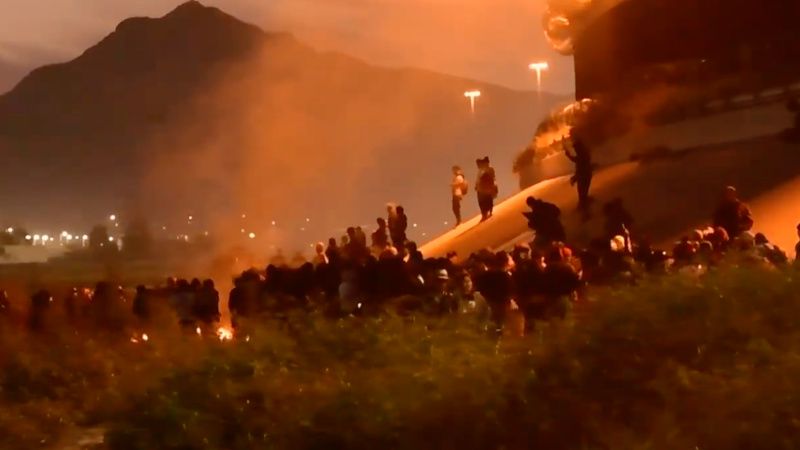El Paso Reels Under Migrant Wave

More than 2,600 migrants are reported to have crossed the Southwest border in Border Patrol’s El Paso sector during a 24-hour period between December 9 and 10.
They were just a “small” portion of the nearly 15,000 migrants apprehended in the sector over the past week, with hundreds more following. It’s beginning to look a lot like the surge that brought thousands of migrants to Del Rio in September 2021, turning “Del Rio” into “shorthand for a border in chaos” — and it’s about to get worse.
BREAKING: A huge migrant caravan of over 1,000 people crossed illegally into El Paso, TX last night, making it the largest single group we have ever seen. The city of El Paso reports Border Patrol now has over 5,000 in custody & has released hundreds to city streets. @FoxNews pic.twitter.com/ewUQX757Lt
— Bill Melugin (@BillFOXLA) December 12, 2022
El Paso Sector. The Border Patrol’s El Paso sector is one of nine along the Southwest border, from the Rio Grande Valley sector on the Gulf of Mexico in the east to San Diego sector on the Pacific Ocean in the west.
El Paso hasn’t traditionally been one of the busiest sectors. In FY 2022, for example, as nearly 481,000 aliens were apprehended down river in Del Rio sector’s area of responsibility, agents along the 284 border miles in El Paso sector’s area of responsibility (which includes all of New Mexico) caught “only” about 308,000 illegal entrants.
Things have been heating up in El Paso of late, however, with apprehensions increasing from fewer than 30,000 in August, to just over 49,000 in September, to more than 53,000 in October (a 280 percent increase over the same month one year before).
Even back in the late summer, however, the local government there was struggling to handle the migrant flow; the city of El Paso started its own busing program to New York City, to deal with the 900 migrants DHS was releasing there daily.
The El Paso Surge. What’s occurring now, however, is on an entirely different scale. Even the New York Times has taken notice (and drawn the “Del Rio” analogy), reporting on December 12:
On Monday, migrants, most of them from Nicaragua, could be seen huddling on street corners or waiting for the bus station to open.
…
The images of large numbers of migrants, wading across low sections of the Rio Grande in El Paso, immediately recalled previous moments of crisis at the southern border, most recently in the small city of Del Rio, Texas where more than 9,000 migrants, mostly from Haiti, crowded in squalid conditions in a temporary camp under a bridge along the river last year.
According to Fox News, before these most recent crossings, Mexican police had escorted 20 busloads of migrants into Ciudad Juarez, directly across the Rio Grande from El Paso, where they were released to local NGOs. Those aliens apparently are among the recent arrivals.
Local outlets in the area reported that some 1,500 Central and South American migrants had arrived in the Mexican state of Chihuahua on December 8 and were being held by authorities in the small city of Jiménez, though it’s unclear whether those migrants are the same as or different from the ones released into Juarez.
As of Sunday, 5,100-plus migrants were being held in the El Paso sector’s central processing facility, well more than its capacity of 3,500, with 1,744 others being released into El Paso over the weekend.
All of this has the city of El Paso weighing whether to declare a state of emergency. According to the local Fox affiliate:
Only the mayor and county judge can declare an emergency, according to state law.
Deputy City Manager, Mario D’Agostino, told city council members Monday there is no guarantee that El Paso will be reimbursed for costs spent on the migration crisis.
He strongly encouraged city leaders to declare a state of emergency with the number of migrants arriving.
If that sounds familiar, it’s because city officials weighed declaring a state of emergency in October, only to opt against it, purportedly due to pressure from the White House on those officials in the heavily Democratic city during the lead-up to the November midterm elections. The election is over, and things along that part of the Rio Grande are only getting worse.
A Harbinger of What’s to Come After Title 42. The New York Times’ reporting continued:
The scenes provided a potential window into the situation that border authorities have been bracing for as early as next week, when a pandemic health policy known as Title 42 is set to expire. The policy, put in place by the Trump administration and continued under President Biden under a court order, has allowed U.S. authorities to rapidly expel migrants, even those seeking asylum, in order to help prevent the spread of the coronavirus.
The “Title 42” policy referenced is a series of health-related CDC orders, issued pursuant to Title 42 of the U.S. Code, that direct the expulsion of illegal entrants in response to the Covid-19 pandemic. The first of those orders was issued in March 2020 during the Trump administration, but they have been reissued and amended several times thereafter, including under the Biden administration.
Still, President Biden applied Title 42 much differently than his predecessor did.
Whereas more than 87 percent of illegal entrants at the Southwest border who were subject to Title 42 were expelled under Trump, only about 58 percent of those apprehended by agents at the U.S.-Mexico line between February and September 2021 were expelled under Title 42, a figure that dropped down to less than 48 percent in FY 2022.
More locally, just 32.6 percent (17,375) of the migrants apprehended in El Paso sector in October were expelled under Title 42, and nearly half (8,124 of 46.7 percent) of them were Mexican nationals.
Much of that recent decline in Title 42 expulsions is likely due to the administration’s aversion to the CDC orders.
On April 6, the administration announced that it would be terminating Title 42, effective May 23. That was challenged by state plaintiffs, and on May 20, Judge Robert Summerhays of the U.S. District Court for the Western District of Louisiana enjoined CDC’s attempts to end Title 42.
On November 17, however, Judge Emmet Sullivan of the U.S. District Court for the District of Columbia issued an order vacating and enjoining Title 42, effective December 21.
The Biden administration is (somewhat inconsistently) appealing Judge Sullivan’s order in an 11th-hour bid to maintain the policy, but when and if Title 42 ends, DHS warns that up to 18,000 migrants per day will enter the United States illegally. The Times’ depiction of the chaos that will ensue at that point is apt.
Today, it’s El Paso struggling with a migrant surge, but post-Title 42, it will be cities and towns all along the Southwest border. Soon after, every community across the country will feel the strain, as schools and emergency rooms fill, and municipal coffers are taxed. It looks like the Mexican government won’t stop migrants from coming, so absent a White House policy reversal, things will just get even worse.
This article was originally published by the Center for Immigration Studies.
Visit BorderHawk.news




